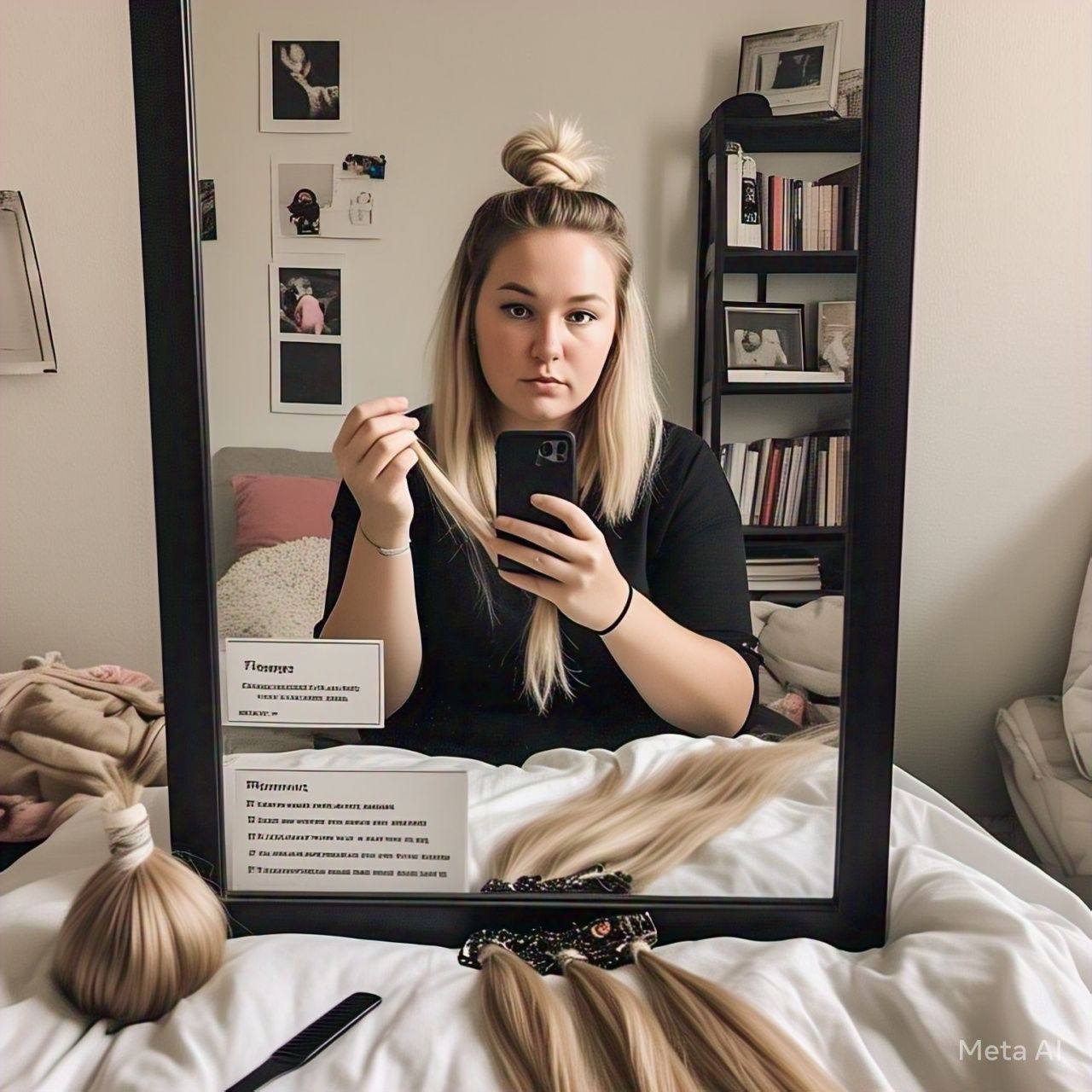Preparation
Understanding Blonde Feed-In Braids
Blonde feed-in braids are a stylish and protective hairstyle that blends synthetic or human hair extensions with natural hair for a seamless, voluminous look. Unlike traditional box braids, feed-in braids start with smaller sections and gradually add hair, creating a more natural and lightweight finish. This technique reduces tension on the scalp, making it a great choice for those who want a protective style without excessive strain.
The blonde shade adds a bold, eye-catching element, making it a popular choice for those who want to experiment with color without permanent dye. Whether for a casual day out or a special occasion, blonde feed-in braids offer versatility while keeping hair protected from damage.
Gathering the Right Supplies
Before beginning the installation process, it is essential to gather all necessary materials. Having everything prepared beforehand ensures a smooth and efficient braiding session. The key items needed include:
Braiding Hair: High-quality synthetic or human hair in a blonde shade is required. Kanekalon or X-Pression hair is commonly used for feed-in braids due to its soft texture and ease of manipulation. The amount needed depends on hair thickness and desired length, but typically, 4-6 packs should suffice for medium-length braids.
Hair Care Products: A moisturizing shampoo and conditioner are necessary to cleanse and hydrate the hair before braiding. A leave-in conditioner, edge control gel, and a light hair oil will help keep the hair nourished and frizz-free during the process.
Tools: A rat-tail comb for parting, hair clips to section hair, scissors for trimming, and a mirror (preferably a handheld one) for precision are essential. Some braiders also prefer using a blow dryer to stretch the hair beforehand for easier braiding.
Additional Supplies: A styling mousse or braiding spray can help with grip, while a silk or satin scarf will protect the hair once the braids are complete.
Preparing Natural Hair for Braiding
Proper preparation is crucial to ensure the braids last long and the natural hair remains healthy. The first step is washing the hair with a clarifying shampoo to remove any product buildup. Follow this with a deep conditioning treatment to add moisture, as braids can lead to dryness over time.
After washing, the hair should be detangled thoroughly using a wide-tooth comb or detangling brush. Starting from the ends and working up to the roots prevents unnecessary breakage. Once detangled, the hair can be blow-dried on a low heat setting to stretch it slightly, making it easier to braid.
Some individuals prefer to lightly stretch their hair using banding or African threading techniques before braiding. This step is optional but can help achieve a smoother base for the feed-in braids.
Choosing the Right Braid Size and Style
Feed-in braids can vary in size—small, medium, or large—depending on personal preference. Smaller braids offer a more intricate look, while larger braids are quicker to install and provide a bolder appearance. The choice also depends on hair density; those with thicker hair may opt for more braids, while finer hair may require fewer to avoid excessive tension.
Additionally, deciding on the braiding pattern is important. Common styles include straight-back braids, side-parted braids, or even a half-up, half-down look. Planning the parting style beforehand ensures a neat and symmetrical finish.
With the hair prepped and supplies ready, the next step is to begin the actual braiding process, which will be covered in Part 2.
Sectioning and Starting the Braids
Creating Clean Partings for the Braids
The foundation of neat feed-in braids lies in precise sectioning. Using a rat-tail comb, the hair should be parted into manageable sections. The size of each section will determine the thickness of the braids. For a uniform look, it is best to measure each section carefully before clipping away the rest of the hair.
A common technique is to start from the front, working backward. A middle or side part can be created first, depending on the desired style. The hair is then divided into horizontal or vertical rows, ensuring each section is even. Hair clips or bands can be used to keep the remaining hair out of the way while focusing on one braid at a time.
Beginning the Feed-In Technique
The feed-in method involves starting with a small amount of natural hair and gradually adding extensions for a tapered effect. To begin, a tiny section of natural hair is taken at the front. A small piece of extension hair is then folded in half and looped around the base of the natural hair, securing it firmly.
The braiding process starts by crossing the right strand under the middle, then the left strand under the new middle. After the first few stitches, a small amount of additional extension hair is fed into the braid by placing it over the existing strand before crossing it under. This technique continues, gradually thickening the braid while keeping the tension even.
Maintaining Consistent Tension
One of the biggest challenges with feed-in braids is maintaining consistent tension throughout. Pulling too tightly can cause scalp discomfort and even hair loss, while braiding too loosely may result in frizzy, uneven braids. The key is to hold the hair firmly but not forcefully, ensuring each new addition blends smoothly.
If the braid starts to feel too tight, it is better to undo a few stitches and re-braid with lighter tension. The goal is to achieve a secure yet comfortable hold that will last for weeks without causing damage.
Securing the Ends of the Braids
Once the desired length is reached, the braid can be secured by either knotting the end or using a small rubber band. Some prefer to dip the ends in hot water to seal them, especially with synthetic hair, as this prevents unraveling. Scissors can be used to trim any excess extension hair for a clean finish.
This process is repeated section by section until the entire head is complete. The next part will cover advanced techniques and styling options for blonde feed-in braids.
Advanced Braiding Techniques and Styling
Perfecting the Feed-In Method for a Natural Look
As the braiding progresses, mastering the feed-in technique becomes crucial for achieving a seamless blend between natural hair and extensions. Unlike traditional braiding, where extensions are added all at once, feed-in braids require gradual incorporation of hair to create a tapered, natural appearance.
To enhance the illusion of thickness, slightly larger pieces of extension hair can be added midway through the braid. This technique prevents the braid from looking too thin at the roots while maintaining a lightweight feel. Additionally, keeping the added hair strands thin and evenly distributed ensures a smooth transition from the scalp to the ends.
For those with shorter natural hair, the feed-in method is especially beneficial. By starting with very small sections and feeding in hair gradually, the braids appear to grow directly from the scalp, eliminating any visible gaps or bulky starts.
Working Through Different Sections of the Hair
Different areas of the head may require slight adjustments in technique. The front hairline, for example, demands extra precision to ensure baby hairs and edges remain undamaged. Using less tension in this area prevents breakage and maintains a natural-looking hairline.
The crown and back sections often have thicker hair, allowing for slightly larger braids if desired. However, consistency is key—keeping the same feed-in pattern throughout ensures uniformity. If the hair is layered, smaller sections may be necessary to catch all strands and prevent loose hairs from slipping out over time.
For a fuller look, some braiders opt to create two separate feed-in braids close to each other and then merge them into one thicker braid midway. This technique adds volume without excessive tension on the scalp.
Adding Blonde Highlights for Dimension
While using a single blonde shade creates a bold statement, incorporating different tones can add depth and realism. Mixing platinum, honey, and sandy blonde extensions mimics natural sun-kissed highlights. This works particularly well for those who want a more dynamic, multi-dimensional look.
To achieve this effect, small sections of varying blonde shades can be alternated during the feed-in process. Another approach is to use two different colors in a single braid—starting with a darker blonde at the roots and transitioning to a lighter shade toward the ends. This ombre effect adds a stylish touch while keeping the braids looking high-end.
Styling Options for Blonde Feed-In Braids
Once all braids are complete, styling possibilities are endless. A simple yet elegant option is to gather the braids into a high ponytail or bun, allowing the blonde tones to stand out. For a more intricate look, braids can be twisted into an updo or pinned into a crown braid.
Side parts with a few face-framing braids create a soft, feminine appearance, while a middle part offers a symmetrical, sleek finish. Accessories such as gold cuffs, beads, or decorative hairpins can be added for extra glamour.
For a bohemian vibe, braids can be left loose with slightly curled ends. Using a curling wand on low heat, small sections of the braids can be wrapped to create loose waves. This adds movement and texture, making the hairstyle look more natural and effortless.
Ensuring Long-Lasting Results
To maximize the lifespan of the braids, a few final steps should be taken. Applying a light edge control gel or styling mousse helps lay down any flyaways and keeps the braids neat. A silk or satin scarf should be wrapped around the hair before bed to reduce friction and prevent frizz.
Additionally, a light oil spray can be used every few days to maintain moisture. However, heavy products should be avoided, as they can cause buildup and make the braids look greasy. With proper care, blonde feed-in braids can last four to six weeks while remaining fresh and stylish.
Maintenance, Troubleshooting, and Final Thoughts
Caring for Blonde Feed-In Braids
Once installed, proper maintenance is key to keeping blonde feed-in braids looking fresh and protecting natural hair underneath. The first 48 hours after braiding are crucial—avoid excessive manipulation to allow the scalp to adjust to the tension. A lightweight oil, such as jojoba or argan oil, can be applied to the scalp to prevent dryness and itching.
Washing the braids requires a gentle approach. Diluted shampoo should be used every 1-2 weeks, focusing on the scalp to remove buildup without disturbing the braids. A nozzle applicator bottle helps distribute the product evenly. After cleansing, a moisturizing conditioner can be applied to the length of the braids, but heavy creams should be avoided as they may loosen the braids over time.
To maintain the blonde color’s vibrancy, a sulfate-free shampoo is recommended to prevent brassiness. A purple shampoo can be used occasionally to neutralize any yellow tones that may develop, especially with synthetic hair.
Nighttime Protection and Frizz Control
Frizz is a common issue with feed-in braids, particularly around the roots and edges. To minimize this, a satin or silk scarf should be wrapped around the head before bed, or a satin pillowcase can be used. This reduces friction and helps preserve the sleekness of the braids.
For stubborn flyaways, a small amount of edge control gel or a light-hold mousse can be applied and smoothed down with a soft brush. However, excessive product use should be avoided, as it can lead to buildup and make the braids appear dull.
Recognizing and Fixing Common Issues
Even with careful installation, problems can arise. If braids feel too tight, causing discomfort or headaches, they should be loosened immediately. Applying warm water or a moisturizing spray to the roots can help ease tension, but if pain persists, a professional may need to adjust them.
Loose braids are another common concern. If a braid begins to unravel, it can be secured with a small rubber band or re-braided from the problem area. For synthetic hair, dipping the end in hot water can reseal it.
Scalp irritation or excessive itching may indicate product buildup or dryness. A clarifying rinse with apple cider vinegar diluted in water can help, but if irritation continues, the braids may need to be removed to prevent damage.
When to Remove the Braids
Blonde feed-in braids typically last 4-6 weeks, depending on maintenance and hair growth. Leaving them in longer can lead to matting and breakage, especially at the roots. Signs that it’s time to remove the braids include excessive frizz, visible new growth, or an itchy, flaky scalp.
Removal should be done carefully to avoid pulling out natural hair. Starting from the ends, each braid can be unraveled slowly, using a detangling spray if necessary. After removal, the hair should be washed, deep-conditioned, and given a break before installing another protective style.
Final Thoughts on Installing Blonde Feed-In Braids at Home
Blonde feed-in braids are a versatile and stylish protective hairstyle that can be achieved at home with patience and practice. From preparation to installation and maintenance, each step plays a vital role in ensuring the braids look polished and last as long as possible.
The key takeaways include:
- Properly preparing natural hair to prevent damage
- Mastering the feed-in technique for a natural, seamless blend
- Choosing the right blonde shades and styling options
- Maintaining the braids with gentle care and nighttime protection
- Recognizing when it’s time to remove the braids to protect hair health
With these steps in mind, anyone can successfully install and maintain blonde feed-in braids at home, enjoying a beautiful, low-maintenance style while keeping their natural hair healthy. Whether for a bold fashion statement or everyday wear, this braiding method offers endless possibilities for creativity and self-expression.










